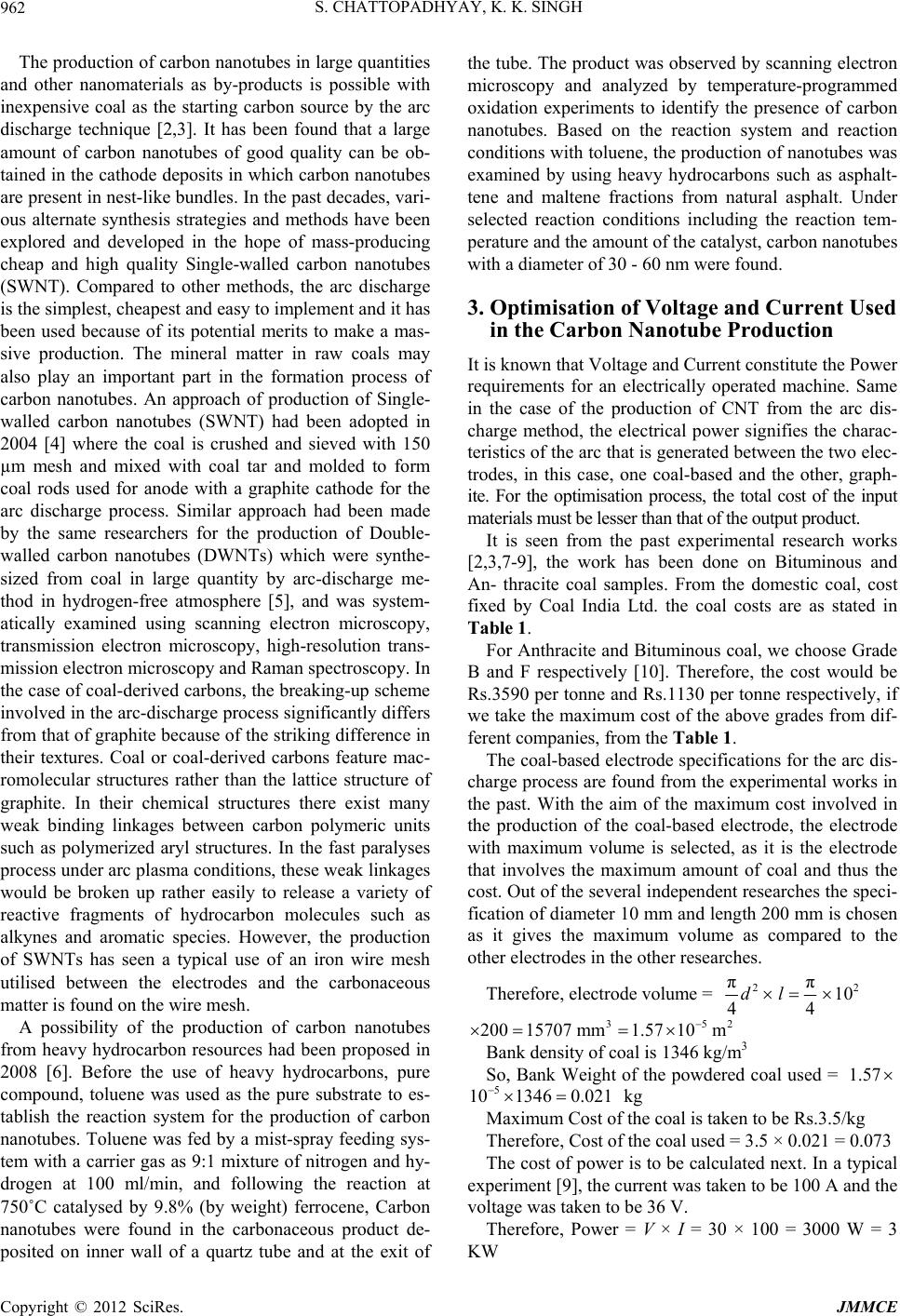
S. CHATTOPADHYAY, K. K. SINGH
962
The production of carbon nanotubes in large quantities
and other nanomaterials as by-products is possible with
inexpensive coal as the starting carbon source by the arc
discharge technique [2,3]. It has been found that a large
amount of carbon nanotubes of good quality can be ob-
tained in the cathode deposits in which carbon nanotubes
are present in nest-like bundles. In the past decades, vari-
ous alternate synthesis strategies and methods have been
explored and developed in the hope of mass-producing
cheap and high quality Single-walled carbon nanotubes
(SWNT). Compared to other methods, the arc discharge
is the simplest, cheapest and easy to implement and it has
been used because of its potential merits to make a mas-
sive production. The mineral matter in raw coals may
also play an important part in the formation process of
carbon nanotubes. An approach of production of Single-
walled carbon nanotubes (SWNT) had been adopted in
2004 [4] where the coal is crushed and sieved with 150
µm mesh and mixed with coal tar and molded to form
coal rods used for anode with a graphite cathode for the
arc discharge process. Similar approach had been made
by the same researchers for the production of Double-
walled carbon nanotubes (DWNTs) which were synthe-
sized from coal in large quantity by arc-discharge me-
thod in hydrogen-free atmosphere [5], and was system-
atically examined using scanning electron microscopy,
transmission electron microscopy, high-resolution trans-
mission electron microscopy and Raman spectroscopy. In
the case of coal-derived carbons, the breaking-up scheme
involved in the arc-discharge process significantly differs
from that of graphite because of the striking difference in
their textures. Coal or coal-derived carbons feature mac-
romolecular structures rather than the lattice structure of
graphite. In their chemical structures there exist many
weak binding linkages between carbon polymeric units
such as polymerized aryl structures. In the fast paralyses
process under arc plasma conditions, these weak linkages
would be broken up rather easily to release a variety of
reactive fragments of hydrocarbon molecules such as
alkynes and aromatic species. However, the production
of SWNTs has seen a typical use of an iron wire mesh
utilised between the electrodes and the carbonaceous
matter is found on the wire mesh.
A possibility of the production of carbon nanotubes
from heavy hydrocarbon resources had been proposed in
2008 [6]. Before the use of heavy hydrocarbons, pure
compound, toluene was used as the pure substrate to es-
tablish the reaction system for the production of carbon
nanotubes. Toluene was fed by a mist-spray feeding sys-
tem with a carrier gas as 9:1 mixture of nitrogen and hy-
drogen at 100 ml/min, and following the reaction at
750˚C catalysed by 9.8% (by weight) ferrocene, Carbon
nanotubes were found in the carbonaceous product de-
posited on inner wall of a quartz tube and at the exit of
the tube. The product was observed by scanning electron
microscopy and analyzed by temperature-programmed
oxidation experiments to identify the presence of carbon
nanotubes. Based on the reaction system and reaction
conditions with toluene, the production of nanotubes was
examined by using heavy hydrocarbons such as asphalt-
tene and maltene fractions from natural asphalt. Under
selected reaction conditions including the reaction tem-
perature and the amount of the catalyst, carbon nanotubes
with a diameter of 30 - 60 nm were found.
3. Optimisation of Voltage and Current Used
in the Carbon Nanotube Production
It is known that Voltage and Current constitute the Power
requirements for an electrically operated machine. Same
in the case of the production of CNT from the arc dis-
charge method, the electrical power signifies the charac-
teristics of the arc that is generated between the two elec-
trodes, in this case, one coal-based and the other, graph-
ite. For the optimisation process, the total cost of the input
materials must be lesser than that of the output product.
It is seen from the past experimental research works
[2,3,7-9], the work has been done on Bituminous and
An- thracite coal samples. From the domestic coal, cost
fixed by Coal India Ltd. the coal costs are as stated in
Table 1.
For Anthracite and Bituminous coal, we choose Grade
B and F respectively [10]. Therefore, the cost would be
Rs.3590 per tonne and Rs.1130 per tonne respectively, if
we take the maximum cost of the above grades from dif-
ferent companies, from the Table 1.
The coal-based electrode specifications for the arc dis-
charge process are found from the experimental works in
the past. With the aim of the maximum cost involved in
the production of the coal-based electrode, the electrode
with maximum volume is selected, as it is the electrode
that involves the maximum amount of coal and thus the
cost. Out of the several independent researches the speci-
fication of diameter 10 mm and length 200 mm is chosen
as it gives the maximum volume as compared to the
other electrodes in the other researches.
Therefore, electrode volume = 22
ππ
10
44
dl
35
20015707 mm1.5710m
2
Bank density of coal is 1346 kg/m3
So, Bank Weight of the powdered coal used = 1.57
kg
5
101346 0.021
Maximum Cost of the coal is taken to be Rs.3.5/kg
Therefore, Cost of the coal used = 3.5 × 0.021 = 0.073
The cost of power is to be calculated next. In a typical
experiment [9], the current was taken to be 100 A and the
voltage was taken to be 36 V.
Therefore, Power = V × I = 30 × 100 = 3000 W = 3
KW
Copyright © 2012 SciRes. JMMCE